Striae Distensae: Clinical Results and Evidence-Based Evaluation of a Novel 675 nm Laser Wavelength
Abstract
1. Introduction
2. Materials and Methods
2.1. Patients Populations and Study Device
2.2. Study Protocol
2.3. Outcomes Assessment
2.4. Side Effects
2.5. Statistics
3. Results
4. Discussion
Limitations of the Study
5. Conclusions
Author Contributions
Funding
Institutional Review Board Statement
Informed Consent Statement
Data Availability Statement
Conflicts of Interest
References
- Borrelli, M.R.; Griffin, M.; Ngaage, L.M.; Longaker, M.T.; Lorenz, H.P. Striae Distensae: Scars without Wounds. Plast. Reconstr. Surg. 2021, 148, 77–87. [Google Scholar] [CrossRef] [PubMed]
- Lokhande, A.J.; Mysore, V. Striae Distensae Treatment Review and Update. Indian Derm. Online J. 2019, 10, 380–395. [Google Scholar]
- Piccolo, D.; Kostaki, D.; Crisman, G.; Conforti, C. Resurfacing with a new 675-nm laser device: A case series. J. Cosmet. Dermatol. 2021, 20, 1343–1345. [Google Scholar] [CrossRef] [PubMed]
- Cannarozzo, G.; Fazia, G.; Bennardo, L.; Tamburi, F.; Amoruso, G.F.; Del Duca, E.; Nisticò, S.P. A New 675 nm Laser Device in the Treatment of Facial Aging: A Prospective Observational Study. Photobiomodul. Photomed. Laser Surg. 2021, 39, 118–122. [Google Scholar] [CrossRef] [PubMed]
- Cannarozzo, G.; Bennardo, L.; Zingoni, T.; Pieri, L.; Duca, E.D.; Nisticò, S.P. Histological Skin Changes After Treatment with 675 nm Laser. Photobiomodul. Photomed. Laser Surg. 2021, 39, 617–621. [Google Scholar] [CrossRef]
- Cannarozzo, G.; Silvestri, M.; Tamburi, F.; Sicilia, C.; Del Duca, E.; Scali, E.; Bennardo, L.; Nisticò, S.P. A new 675-nm laser device in the treatment of acne scars: An observational study. Lasers Med. Sci. 2021, 36, 227–231. [Google Scholar] [CrossRef]
- Nisticò, S.P.; Tolone, M.; Zingoni, T.; Tamburi, F.; Scali, E.; Bennardo, L.; Cannarozzo, G. A New 675 nm Laser Device in the Treatment of Melasma: Results of a Prospective Observational Study. Photobiomodul. Photomed. Laser Surg. 2020, 38, 560–564. [Google Scholar] [CrossRef]
- Bonan, P.; Verdelli, A.; Pieri, L.; Fusco, I. Could 675-nm Laser Treatment Be Effective for Facial Melasma Even in Darker Phototype? Photobiomodul. Photomed. Laser Surg. 2021, 39, 634–636. [Google Scholar] [CrossRef]
- Bonan, P.; Verdelli, A.; Pieri, L.; Fusco, I.; Linpiyawan, R. Facial rejuvenation: A safe and effective treatment with a fractional non-ablative 675 nm laser in Asian population. J. Cosmet. Dermatol. 2021, 20, 4070–4072. [Google Scholar] [CrossRef]
- Beausang, E.; Floyd, H.; Dunn, K.W.; Orton, C.I.; Ferguson, M.W. A new quantitative scale for clinical scar assessment. Plast. Reconstr. Surg. 1998, 102, 1954–1961. [Google Scholar] [CrossRef]
- Elsaie, M.L.; Baumann, L.S.; Elsaaiee, L.T. Striae distensae (stretch marks) and different modalities of therapy: An update. Dermatol. Surg. 2009, 35, 563–573. [Google Scholar] [CrossRef] [PubMed]
- Sadick, N.S.; Magro, C.; Hoenig, A. Prospective clinical and histological study to evaluate the efficacy and safety of a targeted high-intensity narrow band UVB/UVA1 therapy for striae alba. J. Cosmet. Laser Ther. 2007, 9, 79–83. [Google Scholar] [CrossRef] [PubMed]
- Forbat, E.; Al-Niaimi, F. Treatment of striae distensae: An evidence-based approach. J. Cosmet. Laser Ther. 2019, 21, 49–57. [Google Scholar] [CrossRef] [PubMed]
- Khansa, I.; Harrison, B.; Janis, J.E. Evidence-Based Scar Management: How to Improve Results with Technique and Technol-ogy. Plast. Reconstr. Surg. 2016, 138, 165S–178S. [Google Scholar] [CrossRef]
- Lu, H.; Guo, J.; Hong, X.; Chen, A.; Zhang, X.; Shen, S. Comparative effectiveness of different therapies for treating striae dis-tensae: A systematic review and network meta-analysis. Medicine 2020, 99, e22256. [Google Scholar] [CrossRef]
- Ud-Din, S.; McGeorge, D.; Bayat, A. Topical management of striae distensae (stretch marks): Prevention and therapy of striae rubrae and albae. J. Eur. Acad. Dermatol. Venereol. 2016, 30, 211–222. [Google Scholar] [CrossRef]
- Al-Himdani, S.; Ud-Din, S.; Gilmore, S.; Bayat, A. Striae distensae: A comprehensive review and evidence-based evaluation of prophylaxis and treatment. Br. J. Dermatol. 2014, 170, 527–547. [Google Scholar] [CrossRef]
- Ross, N.A.; Ho, D.; Fisher, J.; Mamalis, A.; Heilman, E.; Saedi, N.; Jagdeo, J. Striae Distensae: Preventative and Therapeutic Modalities to Improve Aesthetic Appearance. Dermatol. Surg. 2017, 43, 635–648. [Google Scholar] [CrossRef]
- Neinaa, Y.M.; Gheida, S.F.; El-Aziz Mohamed, D.A. Synergistic effect of platelet-rich plasma in combination with fractional carbon dioxide laser versus its combination with pulsed dye laser in striae distensae: A comparative study. Photodermatol. Photoimmunol. Photomed. 2021, 37, 214–223. [Google Scholar] [CrossRef]
- Shokeir, H.; El Bedewi, A.; Sayed, S.; El Khalafawy, G. Efficacy of pulsed dye laser versus intense pulsed light in the treatment of striae distensae. Comp. Study Dermatol. Surg. 2014, 40, 632–640. [Google Scholar]
- Fatemi Naeini, F.; Nikyar, Z.; Mokhtari, F.; Bahrami, A. Comparison of the fractional CO2 laser and the combined use of a pulsed dye laser with fractional CO2 laser in striae alba treatment. Adv. Biomed. Res. 2014, 3, 184. [Google Scholar]
- Gauglitz, G.G.; Reinholz, M.; Kaudewitz, P.; Schauber, J.; Ruzicka, T. Treatment of striae distensae using an ablative Erbium: YAG fractional laser versus a 585-nm pulsed-dye laser. Case Rep. J. Cosmet. Laser Ther. 2014, 16, 117–119. [Google Scholar] [CrossRef] [PubMed]
- Aldahan, A.S.; Shah, V.V.; Mlacker, S.; Samarkandy, S.; Alsaidan, M.; Nouri, K. Laser and Light Treatments for Striae Distensae: A Comprehensive Review of the Literature. Am. J. Clin. Dermatol. 2016, 17, 239–256. [Google Scholar] [CrossRef]
- Bonan, P.; Verdelli, A. Combined microwaves and fractional microablative CO2 laser treatment for postpartum abdominal laxity. J. Cosmet. Dermatol. 2021, 20, 124–131. [Google Scholar] [CrossRef] [PubMed]
- Mendoza-Garcia, J. Ex vivo evaluation of the effect of photodynamic therapy on skin scars and striae distensae. Photodermatol. Photoimmunol. Photomed. 2015, 31, 239–251. [Google Scholar] [CrossRef]
- Yu, W.; Naim, J.O.; Lanzafame, R.J. Effects of photostimulation on wound healing in diabetic mice. Laser Surg. Med. 1997, 20, 56–63. [Google Scholar] [CrossRef]
- Schindl, A.; Schindl, M.; Pernerstorfer-Schon, H.; Kerschan, K.; Knobler, R.; Schindl, L. Diabetic neuropathic foot ulcer: Successful treatment by low-intensity laser therapy. Dermatology 1999, 198, 314–316. [Google Scholar] [CrossRef]
- Pinheiro, A.L.B.; Pozza, D.H.; de Oliveira, M.G.; Weissmann, R.; Ramalho, L.M.P. Polarized light (400–2000 nm) and non-ablative laser (685 nm): A description of the wound healing process using immunohistochemical analysis. Photomed. Laser Surg. 2005, 23, 485–492. [Google Scholar] [CrossRef]
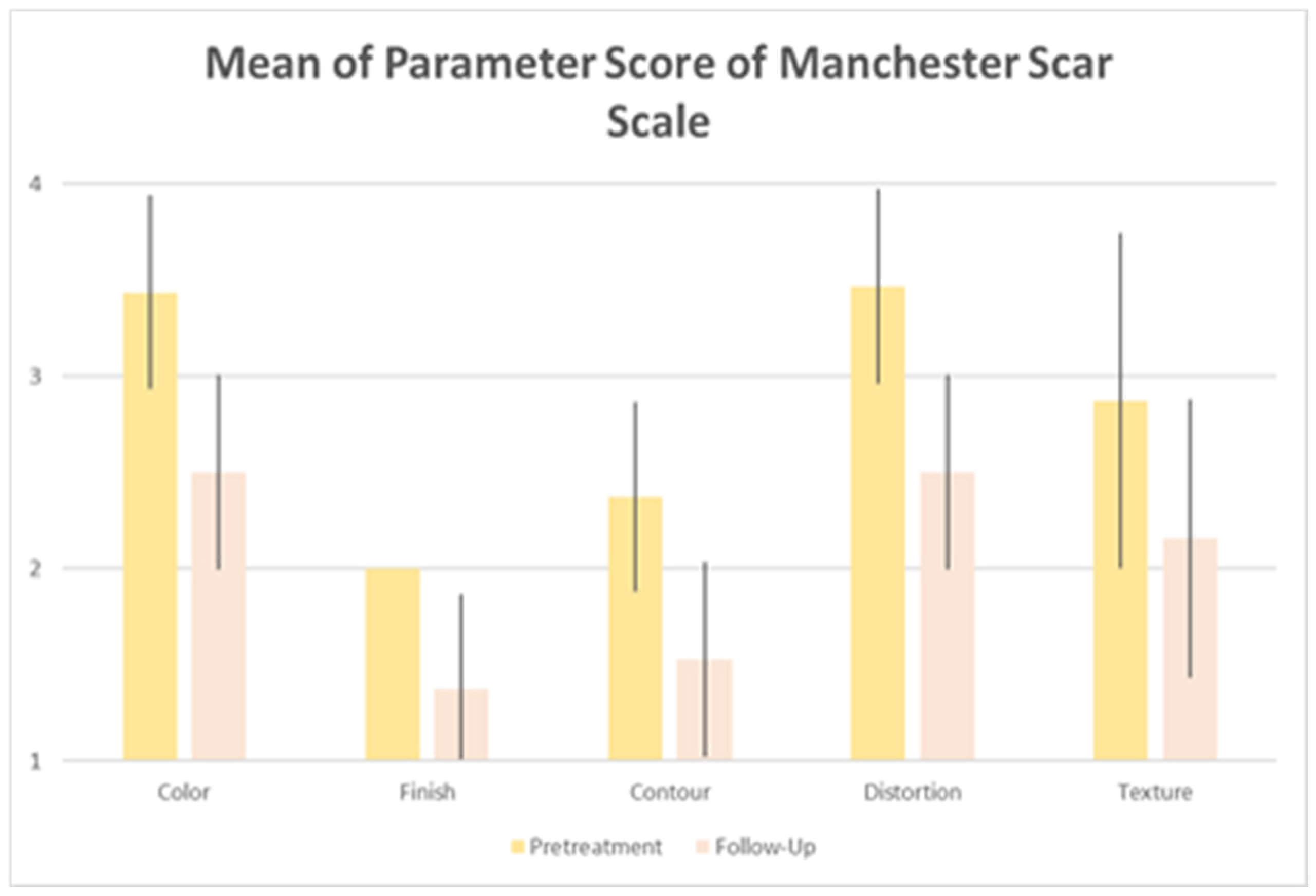
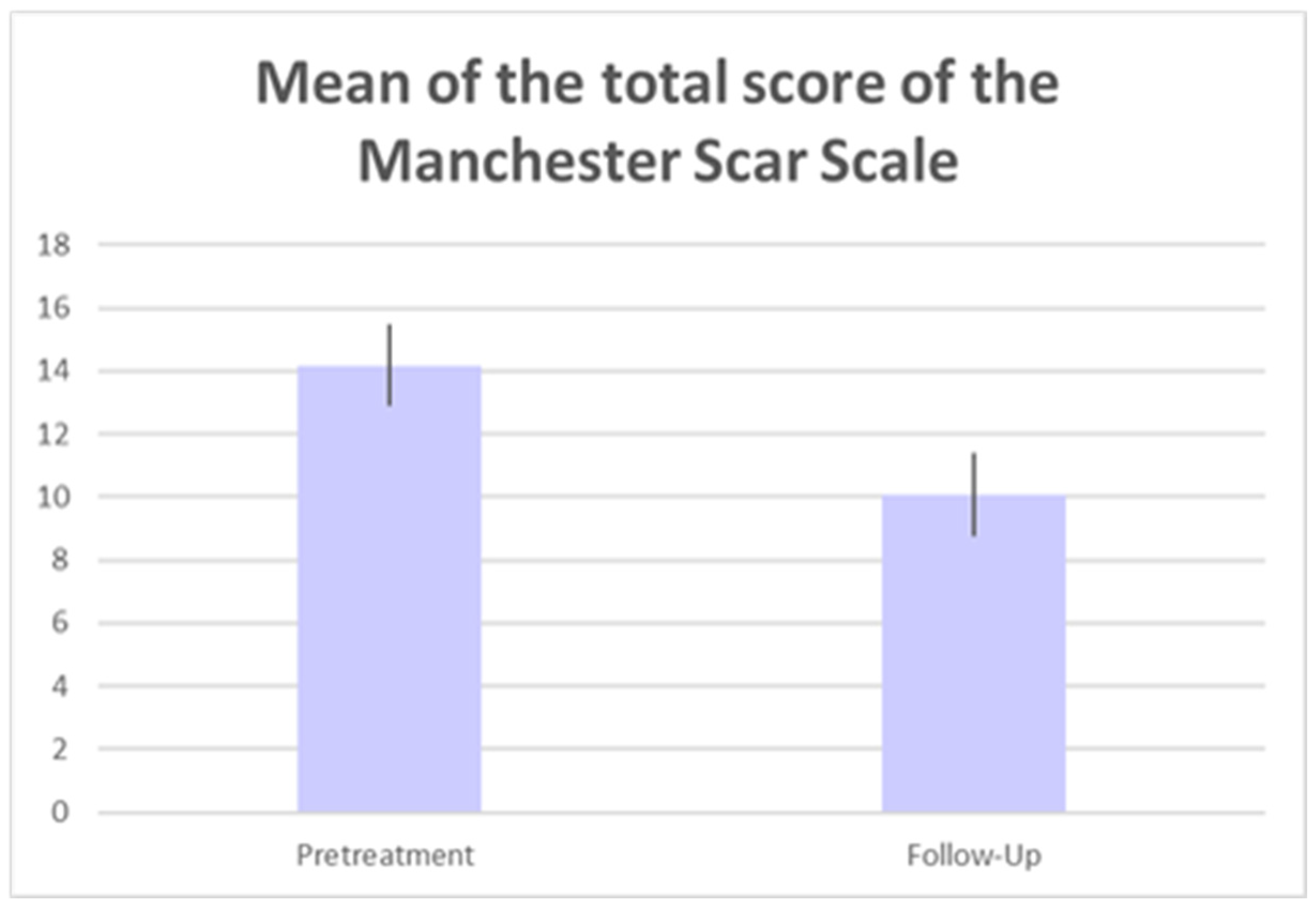
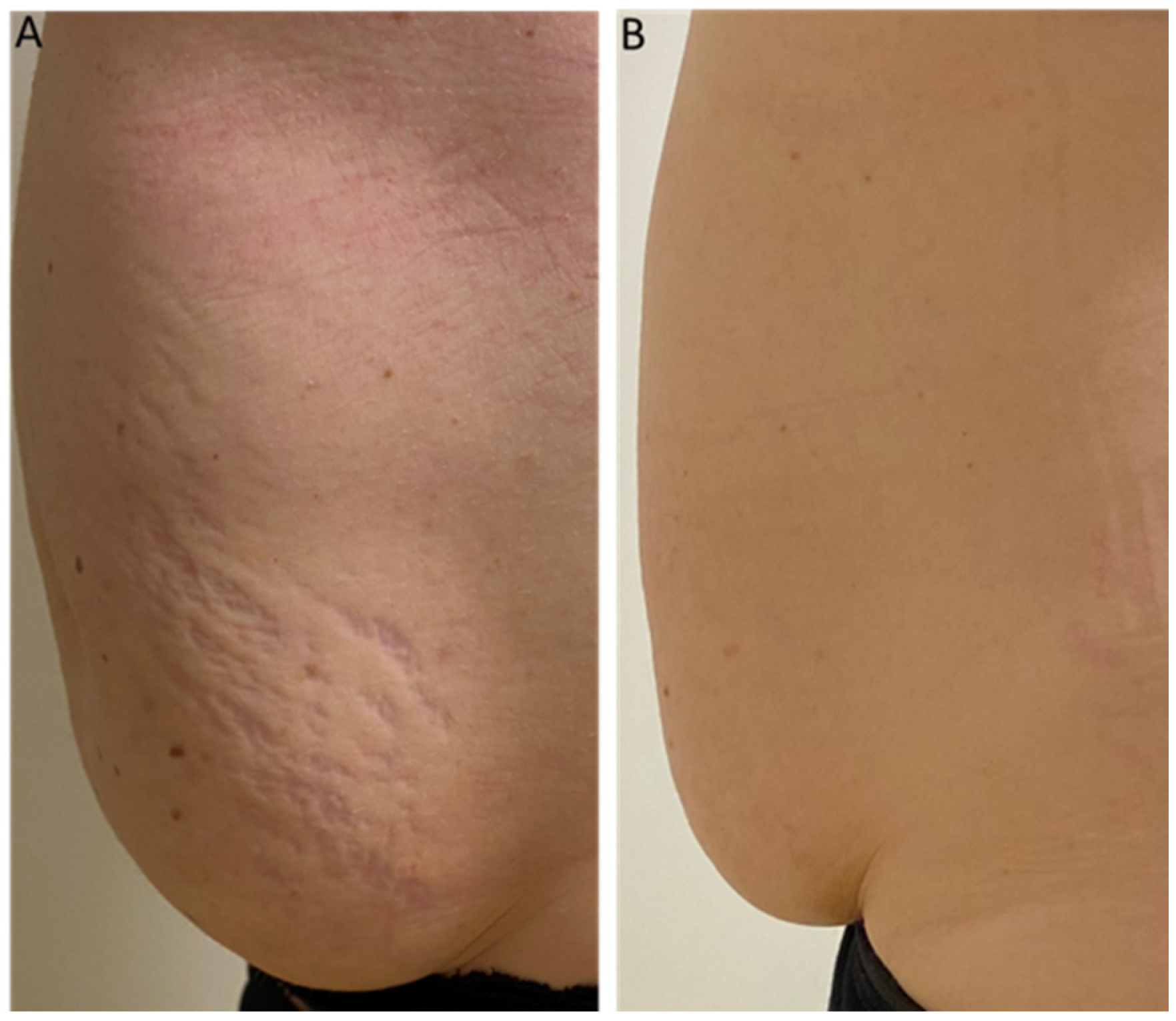
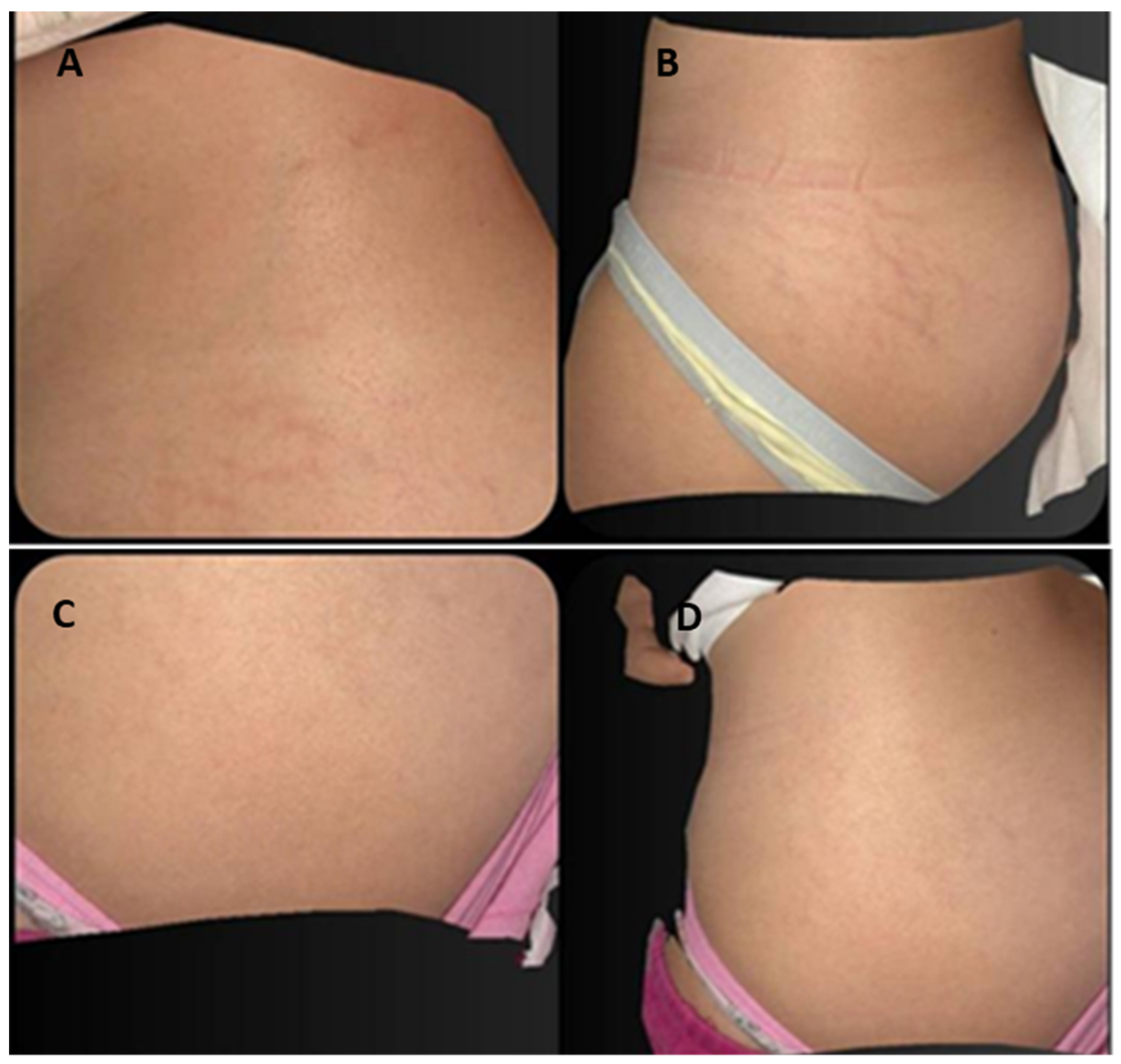
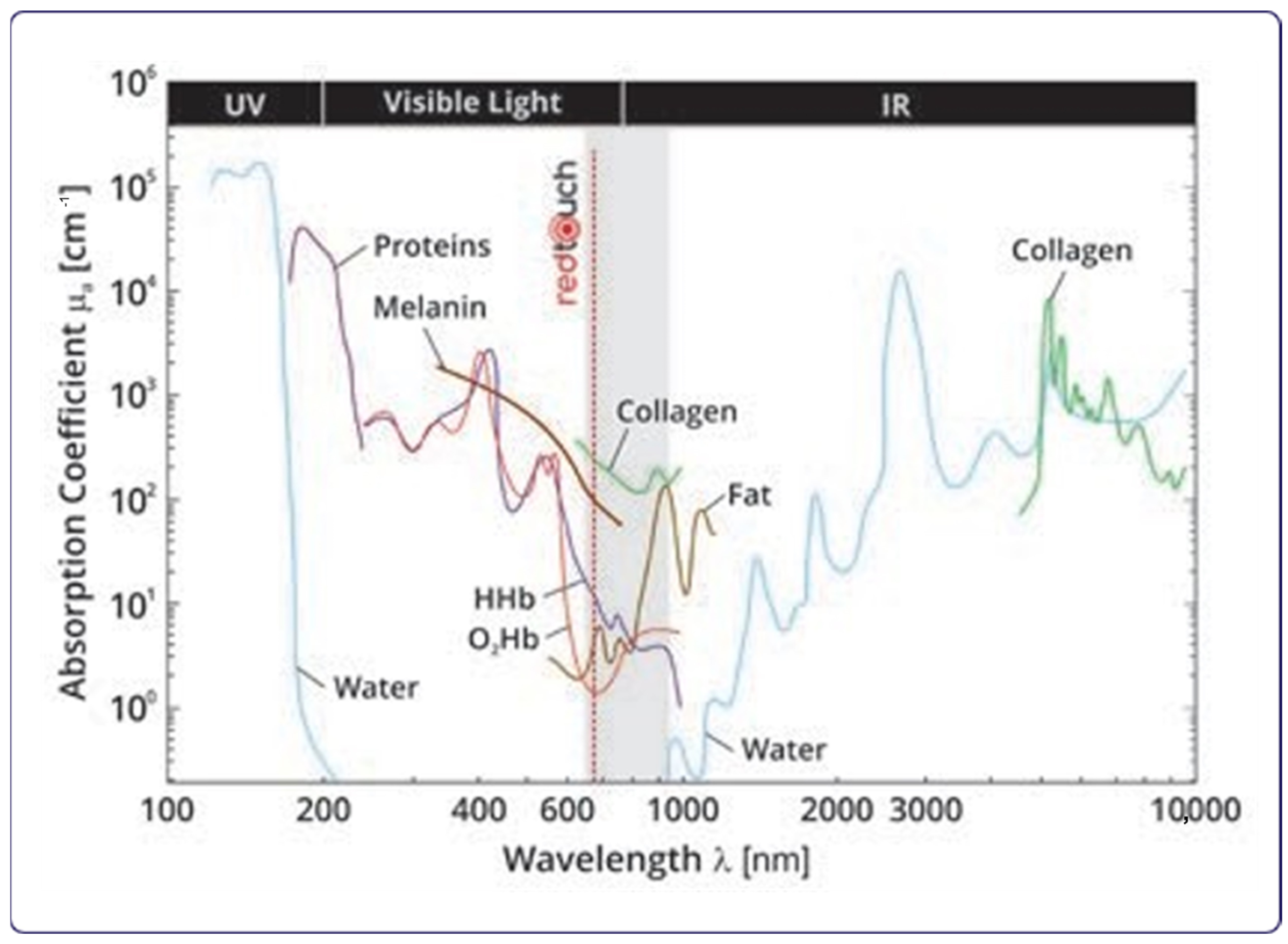
| Parameters of Manchester Scar Scale N = 32 | Baseline Mean ± SD | 6M FU Mean ± SD | (Significance) |
|---|---|---|---|
| Colour (Score range, 1–4) | 3.44 ± 0.50 | 2.50 ± 0.50 | (p ˂ 0.01) |
| Finish (Score range, 1–2) | 2.00 ± 0.00 | 1.37 ± 0.50 | (p < 0.01) |
| Contour (Score range, 1–4) | 2.37 ± 0.50 | 1.53 ± 0.50 | (p < 0.01) |
| Distortion (Score range, 1–4) | 3.47 ± 0.50 | 2.5 ± 0.50 | (p < 0.01) |
| Texture (Score range, 1–4) | 2.87 ± 0.87 | 2.16 ± 0.72 | (p < 0.01) |
| Total score | 14.16 ± 1.30 | 10.06 ± 1.32 | (p < 0.01) |
Disclaimer/Publisher’s Note: The statements, opinions and data contained in all publications are solely those of the individual author(s) and contributor(s) and not of MDPI and/or the editor(s). MDPI and/or the editor(s) disclaim responsibility for any injury to people or property resulting from any ideas, methods, instructions or products referred to in the content. |
© 2023 by the authors. Licensee MDPI, Basel, Switzerland. This article is an open access article distributed under the terms and conditions of the Creative Commons Attribution (CC BY) license (https://creativecommons.org/licenses/by/4.0/).
Share and Cite
Verdelli, A.; Bonan, P.; Fusco, I.; Madeddu, F.; Piccolo, D. Striae Distensae: Clinical Results and Evidence-Based Evaluation of a Novel 675 nm Laser Wavelength. Medicina 2023, 59, 841. https://doi.org/10.3390/medicina59050841
Verdelli A, Bonan P, Fusco I, Madeddu F, Piccolo D. Striae Distensae: Clinical Results and Evidence-Based Evaluation of a Novel 675 nm Laser Wavelength. Medicina. 2023; 59(5):841. https://doi.org/10.3390/medicina59050841
Chicago/Turabian StyleVerdelli, Alice, Paolo Bonan, Irene Fusco, Francesca Madeddu, and Domenico Piccolo. 2023. "Striae Distensae: Clinical Results and Evidence-Based Evaluation of a Novel 675 nm Laser Wavelength" Medicina 59, no. 5: 841. https://doi.org/10.3390/medicina59050841
APA StyleVerdelli, A., Bonan, P., Fusco, I., Madeddu, F., & Piccolo, D. (2023). Striae Distensae: Clinical Results and Evidence-Based Evaluation of a Novel 675 nm Laser Wavelength. Medicina, 59(5), 841. https://doi.org/10.3390/medicina59050841







